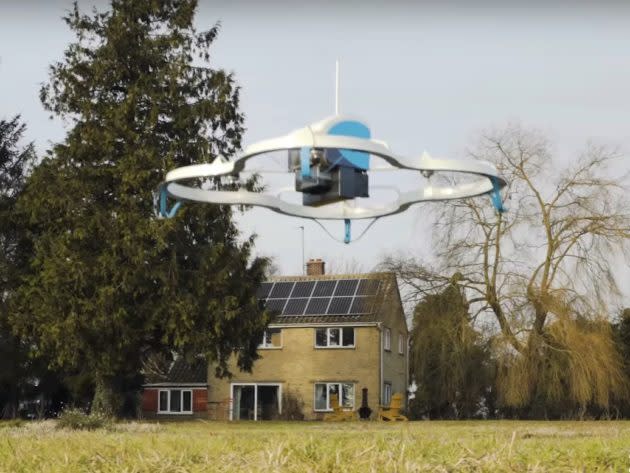Amazon drone deliveries in England show how small steps add up to a big deal

Amazon’s multimillion-dollar effort to deliver goods via drone currently has just two customers in the English countryside, but this could well be the way a multibillion-dollar industry gets started.
The current state of Amazon’s Prime Air project came to light today in an online announcement and video from the Seattle-based company, plus a tweet from CEO Jeff Bezos. The first delivery to an actual customer, identified only as Richard B. of Cambridgeshire, occurred on Dec. 7.
In the coming months, Amazon expects to expand the customer base from the current two to dozens of folks living within several miles of a specially designed drone fulfillment center near Cambridge. Hundreds more will be added as time goes on.
The free deliveries are part of Amazon’s Pathfinder experiment, conducted in cooperation with British aviation officials. In July, an interagency team supported by the Civil Aviation Authority gave Amazon permission to explore three essential pieces of the technological puzzle: operating beyond visual line of sight in rural and suburban areas, testing sense-and-avoid systems to keep drones from running into obstacles, and conducting flights during which one person is in charge of multiple drones.
Amazon’s English deliveries comply with Britain’s requirements for drone experiments: No flying above 400 feet, and no flying after dark or during inclement weather. The drones make autonomous flights over well-charted, relatively bucolic terrain.
The aim is to fine-tune a system in which drones can fly out with packages weighing less than 5 pounds, zoom over to a customer’s home and drop off the package within 30 minutes of an order. The video shows how Amazon’s drone homes in on a pre-printed target that’s set outside what looks like a charming English farmhouse.
Amazon’s drone development program has been making the biggest splash in England, due to the fact that Britain is providing a friendly regulatory environment. “We’re getting really good cooperation,” Bezos said in Seattle in October. But tests are proceeding in other countries as well, including the United States.
The U.S. regulatory situation is a bit more … up in the air, shall we say? The Federal Aviation Administration has designated several sites around the nation as testing grounds for commercial drones. One of them, in Virginia, provided the venue for Google Project Wing’s burrito delivery by drone in September.
A Nevada-based startup called Flirtey has conducted FAA-approved tests of its own drone delivery system in Nevada and along the New Jersey coastline. Meanwhile, a California drone company, Zipline, is already delivering medical supplies to remote areas of Rwanda and is reportedly working with Bloodworks Northwest on a potential trial in Washington’s San Juan Islands.
The test flights in England hint at how drones could start making routine deliveries in the United States as well. The first deliveries are far less likely to be made in downtown Seattle, and far more likely to be made in a rural environment like Amazon’s test site near Snoqualmie, Wash.
It’ll be essential to get the FAA’s approval to operate beyond visual line of sight, with an approved sense-and-avoid system. The FAA has already given PrecisionHawk’s drones the OK to do experimental long-range flights. Just this week, the company provided an update on its Pathfinder Phase 2 research in North Carolina and Kansas. Phase 3 testing is due to begin next month.
Several companies are working on sense-and-avoid systems for drones. It’s not clear which company’s hardware was used for Amazon’s trial runs in England – but a Seattle-area company called Echodyne is working on a miniaturized radar system that’s tailor-made for drones.
The sense-and-avoid system is key to commercializing drone delivery, said Michael Braasch, a professor of electrical engineering at Ohio University who specializes in navigation systems,
“This technology is still in the research phase,” Braasch said in an email to GeekWire. “If the farmer living a couple of miles from Amazon’s fulfillment center needed a helicopter air ambulance, the farmer would probably have to be driven to a spot outside of Amazon’s delivery radius, for safety reasons.”
Braasch said the type of radar technology being developed by Echodyne, plus laser-based sensors under development at Velodyne and many other companies, should solve the sense-and-avoid problem within the next few years.But uUntil then, drone deliveries in the United States are likely to be restricted to closely watched experiments like Project Wing’s burrito run.
“A system certified for commercial drone use (beyond the horizon) in the U.S. likely will not happen before the end of this decade,” Braasch said.
When the FAA gives the go-ahead for drone deliveries, the payoff is expected to be huge: A report published by PricewaterhouseCoopers LLP in May estimated that the global market for commercial drone applications, including package delivery, could rise to as much as $127 billion by 2020.
More from GeekWire:
Reporter hunts for Amazon’s drone testing site in Britain, but drones aren’t at home
Video: Amazon makes first Prime Air drone package delivery, offers glimpse of new aircraft design
Amazon patent filing provides a peek at shrouded delivery drone designs
Amazon seeks patent for system that links up drones to create a Borg for deliveries
